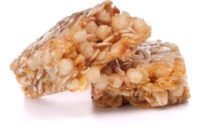Choose between milk and whey proteins
Milk proteins and whey proteins serve different functional purposes as ingredients

Dairy foods, including dry dairy ingredients, provide one-fifth of the total daily protein intake for the average American. Amidst a crowded protein market, demand for dairy proteins continues to grow.
The body requires a constant external supply of nine different essential amino acids (EAAs) that it can’t make on its own. Easily digestible dairy proteins are high-quality, complete proteins that deliver all nine EAAs. Dairy protein nutrition research has shown that they support muscle recovery, weight management and satiety.
There are two main categories of dairy proteins: milk proteins and whey proteins.
Milk versus whey proteins
Milk protein ingredients include milk protein concentrates (MPCs), with 50-90% protein and milk protein isolates (MPIs), with at least 90% protein. MPCs and MPIs contain the same 80%-casein-to-20%-whey protein ratio found in milk.
Milk proteins can be used as emulsifiers, flavor enhancers, formulation aids, humectants, stabilizers and thickeners, texturizers and sources of high-quality protein.
MPCs are used for manufacturing foods that include ice cream, yogurt/fermented dairy, meal replacement beverages, soups, sauces and snacks. MPIs are produced by filtration methods that capture essentially all the casein and whey proteins and separate out most of the lactose and minerals. They are commonly used in value-added products such as dietetic and high-protein clinical formulations.
Whey proteins such as whey protein concentrates (WPCs) and whey protein isolates (WPIs) are soluble over a wide pH range; create viscosity through water-binding; form gels; emulsify; bind fat; facilitate whipping, foaming and aeration; enhance color, flavor and texture; and offer numerous nutritional advantages.
Unlike casein, whey proteins will denature upon heating starting at about 145 degrees Fahrenheit, and they will eventually form a gel at a high enough concentration (about 7% protein). Whey proteins do not form acid gels like caseins, which is a key difference to consider for a yogurt application.
Whey proteins are a source of highly bioavailable calcium, making them particularly valuable in beverages for children, pregnant women and seniors. They are also used in many other foods, including yogurt, cookies and crackers, pasta, dressings and sauces, and probiotic drinks.
Functional differences
Although milk and whey proteins provide similar protein levels, they each offer a different set of functional properties due to the type of protein that is most prevalent. MPC is 80% casein and 20% whey protein, whereas WPC contains all whey protein.
Knowing the pH of the food and understanding how the dairy protein will behave in those pH conditions are critical to choosing the right ingredient. For example, to make a protein beverage in the pH range of 3.0 to 4.5, manufacturers typically use a hot-fill process. Therefore, a whey protein is the right choice because a milk protein will have poor solubility and will precipitate. However, for a beverage in the pH range of 6.5 to 7.0, the heat stability of a milk protein is key because an ultra-high-temperature process will be necessary to make a shelf-stable product.
Proper hydration
Hydration requirements are another major difference. Proper hydration is critical to ensuring clarity, heat stability and satisfactory sensory characteristics in the finished beverage or food product. For example, if the protein is not properly hydrated prior to use, it may cause product quality defects such as a grainy/chalky texture, precipitation or a general lack of water binding in the finished product.
While hydration is not technically complex, it’s often not executed correctly. Processors experiencing these problems often assume the protein is defective or won’t work in their application when, in fact, the only issue is lack of proper hydration. For optimal performance, it’s critical, therefore, to follow the protein supplier’s usage instructions.
Visit ThinkUSAdairy.org for more information about how to choose the right dairy protein ingredient.
Looking for a reprint of this article?
From high-res PDFs to custom plaques, order your copy today!




